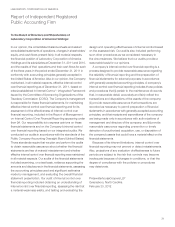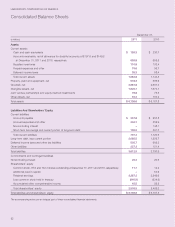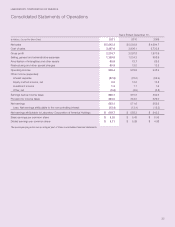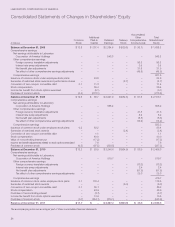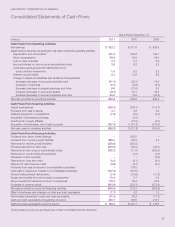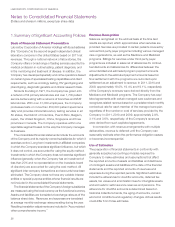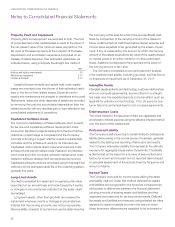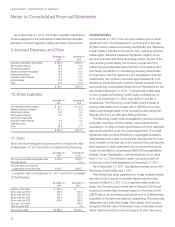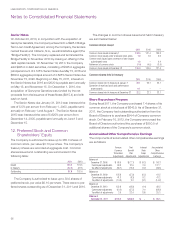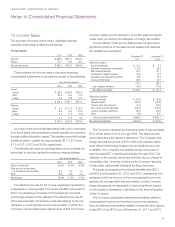LabCorp 2011 Annual Report Download - page 31
Download and view the complete annual report
Please find page 31 of the 2011 LabCorp annual report below. You can navigate through the pages in the report by either clicking on the pages listed below, or by using the keyword search tool below to find specific information within the annual report.29
LABORATORY CORPORATION OF AMERICA
Notes to Consolidated Financial Statements
settled. The effect on deferred tax assets and liabilities of a
change in tax rates is recognized in income in the period that
includes the enactment date. The Company does not recognize
a tax benefit, unless the Company concludes that it is more
likely than not that the benefit will be sustained on audit by the
taxing authority based solely on the technical merits of the
associated tax position. If the recognition threshold is met, the
Company recognizes a tax benefit measured at the largest
amount of the tax benefit that the Company believes is greater
than 50% likely to be realized. The Company records interest
and penalties in income tax expense.
Derivative Financial Instruments
Interest rate swap agreements, which have been used by the
Company from time to time in the management of interest
rate exposure, are accounted for at fair value. The Company’s
zero-coupon subordinated notes contain two features that
are considered to be embedded derivative instruments under
authoritative guidance in connection with accounting for
derivative instruments and hedging activities. The Company
believes these embedded derivatives had no fair value at
December 31, 2011 and 2010.
See note 18 for the Company’s objectives in using derivative
instruments and the effect of derivative instruments and
related hedged items on the Company’s financial position,
financial performance and cash flows.
Fair Value of Financial Instruments
Fair value measurements for financial assets and liabilities are
determined based on the assumptions that a market participant
would use in pricing an asset or liability. A three-tiered fair
value hierarchy draws distinctions between market participant
assumptions based on (i) observable inputs such as quoted
prices in active markets (Level 1), (ii) inputs other than quoted
prices in active markets that are observable either directly or
indirectly (Level 2) and (iii) unobservable inputs that require the
Company to use present value and other valuation techniques
in the determination of fair value (Level 3).
Research and Development
The Company expenses research and development costs
as incurred.
New Accounting Pronouncements
In September 2011, the FASB issued authoritative guidance
to amend and simplify the rules related to testing goodwill for
impairment. The revised guidance allows an entity to make an
initial qualitative evaluation, based on the entity’s events and
circumstances, to determine whether it is more likely than not
that the fair value of a reporting unit is less than its carrying
amount. The results of this qualitative assessment determine
whether it is necessary to perform the currently required two-
step impairment test. The new guidance is effective for annual
and interim goodwill impairment tests performed for fiscal
years beginning after December 15, 2011, with early adoption
permitted. Adoption of this guidance is not expected to have
a material impact on the Company’s consolidated financial
statements.
In July 2011, the FASB issued authoritative guidance on
the presentation and disclosure of patient service revenue,
provision for bad debts, and the allowance for doubtful accounts
for certain health care entities. This literature was issued to
provide greater transparency about a health care entity’s net
patient service revenue and the related allowance for doubtful
accounts. Specifically, this literature requires the provision for
bad debts associated with patient service revenue to be
separately displayed on the face of the statement of operations
as a component of net revenue for health care entities that
provide services regardless of a patient’s ability to pay. The
guidance also requires enhanced disclosures of significant
changes in estimates in the provision for bad debts relating
to patient services when an entity recognizes revenue regard-
less of a patient’s ability to pay. This guidance is effective for
fiscal years and interim periods beginning after December 15,
2011, with early adoption permitted. The Company does not
believe the adoption of the authoritative guidance in the first
quarter of 2012 will have an impact on its consolidated
financial statements.
In June 2011, the FASB issued authoritative guidance on
the presentation of comprehensive income. Specifically, this lit-
erature allows an entity to present components of net earnings
and other comprehensive income in one continuous state-
ment, referred to as the statement of comprehensive income,
or in two separate, but consecutive statements. The authorita-
tive guidance eliminates the current option to report other
comprehensive income and its components in the statement
of changes in shareholders’ equity. While the authoritative
guidance changes the presentation of comprehensive income,
there are no changes to the components that are recognized
in net earnings or other comprehensive income under current




